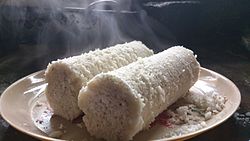Puttu

Puttu
|
|
| Course | Breakfast |
|---|---|
| Place of origin | Sri Lanka & India |
| Region or state | India (in Kerala, border regions of Tamil Nadu, Kanara region of Karnataka), Sri Lanka, Singapore, Malaysia (as putu bambu), Philippines (as puto bumbóng) and Indonesia (as kue putu) |
| Main ingredients | Rice flour, coconut |
| |
|
Puttu pronounced [ˈputtu], (Malayalam: പുട്ട്), (Kannada: ಪುಟ್ಟು), (Tamil: புட்டு), (Sinhala පිට්ටු ) is a breakfast dish eaten in Kerala, parts of Tamil Nadu, the Kanara region of Karnataka and Sri Lanka. Puttu or pittu is a word of Tamil origin which means "portioned". It is made of steamed cylinders of ground rice layered with coconut. It is highly popular in the Indian state of Kerala as well as in many areas of Sri Lanka, where it is also known as pittu. Puttu is served with side dishes such as palm sugar or chickpea curry or banana. In Bhatkal Puttu is served with side dishes such as ghee and sugar or Paya or mutton curry.
Puttu principally consists of coarsely ground rice, grated coconut and water. It is often spiced with cumin, but may have other spices. The Sri Lankan variant is usually made with wheat flour or red rice-flour without cumin whereas the Bhatkal recipes have plain coconut or masala variant made with mutton or shrimp flavoured grated cocunut.
Puttu is made by slowly adding water to ground rice until the correct texture is achieved. It is then spiced, formed and steamed with layers of grated coconut.
Puttu is generally cooked in a metal puttu kutti vessel with two sections. The lower section holds water and the upper section holds the puttu — where the rice mixture is inserted with layers of grated coconut. Perforated lids separate the sections to allow the steam to pass between them.
...
Wikipedia
